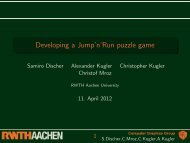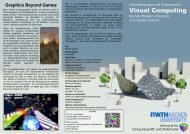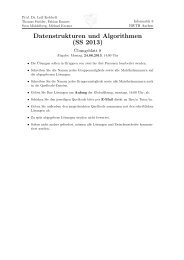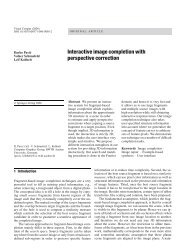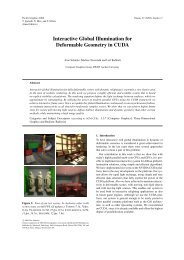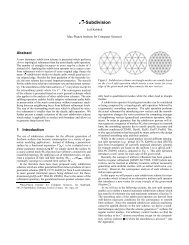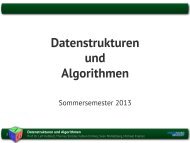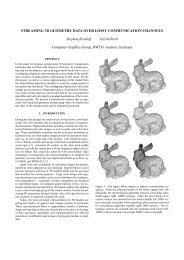Structure Preserving CAD Model Repair - OpenFlipper
Structure Preserving CAD Model Repair - OpenFlipper
Structure Preserving CAD Model Repair - OpenFlipper
You also want an ePaper? Increase the reach of your titles
YUMPU automatically turns print PDFs into web optimized ePapers that Google loves.
Stephan Bischoff & Leif Kobbelt / <strong>Structure</strong> <strong>Preserving</strong> <strong>CAD</strong> <strong>Model</strong> <strong>Repair</strong><br />
Helicopter, 10 k triangles in 60 patches, γ = 1<br />
resolution 1024 3 2048 3 4096 3 8192 3<br />
#critical vertices 242 k 505 k 1037 k 2079 k<br />
#critical cells 68 k 141 k 277 k 561 k<br />
#output triangles 28 k 34 k 44 k 60 k<br />
time 47 s 116 s 291 s 868 s<br />
Camera, 19 k triangles in 83 patches, γ = 1<br />
resolution 128 3 256 3 512 3<br />
#critical vertices 192 k 655 k 1978 k<br />
#critical cells 83 k 270 k 874 k<br />
#output triangles 33 k 61 k 81 k<br />
time 56 s 145 s 639 s<br />
Figure 10: Camera<br />
Figure 9: Helicopter<br />
5. Discussion<br />
We have presented a new and efficient algorithm for fully<br />
automatic and selective repair of tessellated <strong>CAD</strong> models.<br />
However, a number of issues are still open for future work.<br />
Artifacts within a single patch Our algorithm does reliably<br />
detect and resolve artifacts between different patches.<br />
However, it does not resolve artifacts within a single patch,<br />
like e.g. self-intersections. Of course, we could extend our<br />
algorithm to also handle such artifacts, but that would significantly<br />
decrease its performance. The reason is, that during<br />
the construction of the vertex octree, we often have to check<br />
whether a certain box contains two or more patches. Currently<br />
this check is very fast, as we only have to compare the<br />
patch IDs of the participating triangles. However, if we also<br />
wanted to detect self-intersections within a single patch, we<br />
would actually have to intersect each triangle with all other<br />
triangles in the box. This can be done very fast [SAUK04]<br />
but as none of our models has self-intersecting patches, we<br />
conclude that such a situation does not happen very often in<br />
practice. If it does, the user has to manually divide the patch<br />
into non-self-intersecting subpatches.<br />
Selectivity Our algorithm does only modify critical regions<br />
of the model, i.e. regions containing intersections or gaps,<br />
and preserves the structure of the tessellation everywhere<br />
else. These critical regions are determined fully automatically<br />
from a global user-defined parameter γ 0 . It should,<br />
however, be possible to let this parameter locally depend on<br />
the underlying model geometry such as to close gaps of different<br />
sizes. It should also be possible to apply one of the<br />
surface oriented mesh repair algorithms in a preprocessing<br />
step to segment the input into large and manifold patches<br />
wherever possible and apply our method only to those regions<br />
where the surface oriented methods fail.<br />
Reconstruction We reconstruct the surface in the critical<br />
regions from a grid of directed distances using a novel<br />
contouring algorithm. This algorithm correctly resolves any<br />
self-intersections based on the local configuration of the cuts<br />
around a grid face only. However, other (possibly global)<br />
criteria might also be incorporated. For example, we might<br />
strive for a reconstruction of minimal genus or of minimal<br />
number of connected components. For a standard grid of<br />
signed distances and the Marching Cubes algorithm, this has<br />
already been explored by Andujar et al. [ABC ∗ 04].<br />
Space and time efficiency Due to its selectivity, our algorithm<br />
already proved to be quite space and time efficient.<br />
In our implementation we have used standard libraries for<br />
the octree and mesh data structures and for the exact arithmetic<br />
and the mesh decimation framework. We believe that<br />
we could achieve considerable speed ups and lower memory<br />
usage if we used custom-tailored data structures and algorithms<br />
instead. As our algorithm operates on local information<br />
only, it should also be easily possible to generalize it to<br />
parallel machines.<br />
c○ The Eurographics Association and Blackwell Publishing 2005.



